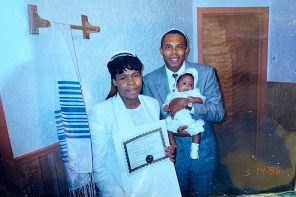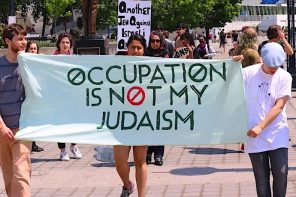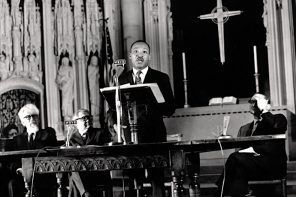The single-dwelling home has long been seen as the consummate test of an architect’s skill. For Jonathan Block Friedman, a theoretical architect and professor at Long Island’s New York Institute of Technology, that test left out buildings designed for community functions: birth, death, and marriage. “Just as we cannot specify the surroundings of our own births, nor supervise our own burials,” Friedman explains, “some architectural concerns require a consciousness of the world as a community.”
Friedman’s extension of that question to synagogue architecture is the basis for a new exhibit of his work, “Idea About Synagogue,” based on series of plans for synagogues inspired by the 22 letters of the Hebrew alphabet, closing on April 9 at NYIT. The idea sprang, somewhat improbably, from his early teaching years at the University of Kentucky in the late ’70s, when a student (“maybe one of the other 15 Jewish guys in Kentucky at the time,” Friedman says) asked him why there was no history of synagogue architecture comparable to that taught about Christian cathedrals.
Friedman wrote a nearby theological seminary in Cincinnati with the question, and received several articles written by a liturgist outlaying the few, basic mandates for synagogue design: that the Ark of the Torah be on the east side; that there be a window to the community, to prevent isolation from society; and that the bimah, or altar, be no more than six steps above the congregation, to curb haughtiness among the clergy. With the basic scriptural requirement of a synagogue being not a building, nor having a rabbi, but merely a quorum of ten Jews, Friedman says that the form of synagogues have a primary democratic impulse.
“The basic thing I took away, is that I thought, all these years I’ve been in a synagogue and I’ve thought of it as a movie theater: everybody sits in rows and looks at this thing in the front. But it didn’t have to be that way.”
Open-Air Worship, and Then Some
The nine un-built synagogues Friedman has designed since then, working sequentially through the alphabet to cover Aleph, Bayt, Gimel, Dalet, Vav, Zion, Het, Tet and Yud (Friedman has postponed Hei—Hebrew’s silent letter, signifying the name of God—until the end of his series), are a far cry from standard architecture for houses of worship. The buildings tend toward open-air worship, spread over a large campus designed for multi-functionality, with synagogue buildings doubling as water purifying stations, salt water batteries, flash fire-resistant refugee homes, floating nuclear fallout shelters, and pogrom-proof urban fortresses.

Friedman, who happily calls himself an “alien freak,” and a child of the sixties who has dabbled and sought in many traditions, including Christianity, Buddhism, and the amorphous spirituality of 1960s-era California, is an intermittently observant member of a Reconstructionist Jewish congregation, a branch of Judaism that stresses evolving interpretations of religious tradition. It’s a style of Judaism that Friedman believes lends itself to reassessment and entertaining new ideas, like synagogues without rain shelters.
In many ways, the show functions as a retrospective of Friedman’s work: from the carpeted floor transformed into a 64-square grid, to note Friedman’s age, to the bracketing of the show with Friedman’s earliest influences—model Logstix constructions and toy trucks from his suburban Long Island childhood—to the full span of his 40-year project of Yom Kippur self-portraits. But the synagogues themselves are heavily inflected with traces of Friedman’s biography as well: Aleph began near the start of Friedman’s teaching career; Bayt was drafted as his parents were contending with illness as “sweethearts of the radiation wing,” and took as inspiration Friedman’s experiences at Degania Aleph, the first kibbutz in Israel; Gimel was conceived during the atmospheric early-’80s fears of nuclear annihilation; and Dalet sprung from Friedman’s frustrating tenure in local government.
Arks, Orbs, Rings, Pods
A mystical tradition in Judaism vests Hebrew letters with personalities and meanings of their own, and as Friedman’s synagogues follow from his biography, so they also do from this lexicon. Synagogue Gimel, evolved from the word for camel—as Friedman notes, the “ship of the desert”—is a shape-shifting ark designed to withstand a modern-day catastrophe on the scale of the biblical flood. As a solitary, ocean-going orb, possibly made of transparent aluminum, Gimel (Friedman’s rabbi’s favorite plan) would contain within its sphere a comprehensive gene bank for the world’s life that, more practically than paired animals, could reseed a post-apocalyptic world. When the orb beaches on dry land (potentially Jones Beach, as Friedman sold the idea to his parents), a phased construction project would erect a torus, or ring, of 12 replicate pods that could germinate new plant and animal life and later orbs dedicated to schooling, prayer, dance, and recreation. There’s scriptural precedent, says Friedman, as the Torah is the “seed-pod” from which other Jewish writings can regenerate. “As long as you save the Torah, you can always write the commentaries. As long as you have the original, authoritarian words, things can be reborn healthfully.”
Friedman’s fourth synagogue, Dalet, likewise interprets the letter’s meaning of “door,” and its associations with poverty, humility and selflessness. Friedman’s inspiration for Dalet is tinged with anger from his participation in the City Council of Glen Cove at the time of the 1990 Avianca airline crash in the nearby Long Island town of Cove Neck—a flight from Columbia to New York that ran out of fuel as it was held circling JFK airport awaiting permission to land, killing 73. In the midst of a subsequent council meeting, the mayor of Glen Cove sequentially cited the heroics of local emergency workers for responding to the crash, and then lamented the presence of immigrant Latino day laborers in the town streets.
“I couldn’t resist responding to the irony, and I stood up and said, ‘It seems to me the only way you can be Hispanic and welcomed in Glen Cove is if you come flaming from the skies in an airplane,’” says Friedman. “It got me thinking about refugees.” The synagogue that resulted, designed to be built in the Australian outback, features an open-air bimah and bleacher-style pews (bridging a forest-fire resistant pool), where services are held before an audience of refugees living in an on-site block of temporary housing apartments.
“Since Dalet means door, among other things, I started thinking about Lazarus, and ‘I lift my light besides a golden door,’ and refugees in relation to the people who go to pray on a nice Saturday or Sunday. [For them] everything is lovely, and they have their children and grandchildren coming over later, and they feel like all is right with the world, and they go home because they have a home, unlike half the world which is dispossessed or relocated.” The refugees watching the congregation watching the service—which could be creepy, Friedman concedes—become “a literalization, a physical reality of the conscience.” And the rooms would always be full, “because, like Jesus said, there will always be the poor. When they’re empty, the world is at peace, and everyone is home.”
Synagogue Vav, which besides Gimel might be Friedman’s most strikingly surreal design, is also the plan he thinks stands the best chance of realization. Conceived as two intersecting tetrahedrons that form a Jewish star from every perspective—in Hebrew, Vav signifies “and”—the building would not touch the ground, but rather its frame of metal pipes would rest in a city block between two supporting buildings. Friedman has a block in mind, on Manhattan’s Upper West Side, where the oldest Reform synagogue in the country, Congregation B’nai Jeshurun, resides. In an alternate history, where Vav was built in its place, the ground below it would become a downward spiraling, sustainable urban graveyard, with the oldest ancestors buried closest to the surface. Within the structure, stadium-style seats line each steep wall, and the sloping wheelchair-accessible ramps leading up to the entrance could flip up like gangplanks in times of persecution.
Gas Stations Don’t Have To Argue for Their Existence
Other works of Friedman’s speak to a similar preoccupation with the question of community. Home for Generations, a model home for a middle-density community intended to supplant the quintessential suburban sprawl of Levittown, turns flat, ticky-tacky housing developments into postmodern villas on the same plots of land, sculpted into hills, for what Friedman envisions as a Mediterranean quality of life that integrates older relatives into one extended family home. (“I always thought the problem with suburbia is that it needs the Waltons and their extended family,” says Friedman.) It’s even there in what Friedman calls his “space digression,” a series of exo- and extra-terrestrial plans for moon tourism, outerspace recreation, and plans patented in 1981 for an Earth Photo Globe that could offer the earth-bound the same awesome vantage of their home planet that astronauts have seen. (Also, predicting Google Earth by nearly 30 years, the Earth Photo Globe plans suggested using satellite technology to zero in on viewers’ individual houses).
Synagogues like these, it’s safe to say, have never been built. Whether they should be, even Friedman isn’t sure. And not just because they might fall down, get hit by lightning, or, as he fears for Gimel, leak. Friedman’s plans fit into a tradition of un-built architecture, including the works of Venetian architect Andrea Palladio, whose 16th-century palaces were never built in Italy, but, centuries later, became the inspiration for English country manors; or, in modern times, the utopian city plans of Frank Lloyd Wright and Le Corbusier.
“They did other buildings, but they never built cities. But they were brave enough to say, I’m going to look at the whole thing, how people live, from the fire hydrant to the highway, wherever the city is. And this gives me that opening in a way—that each of these little microcosms asks little questions.”
The recurring question, for Friedman’s synagogues, is obvious.
“I would say in the end, the questions it raises about community are at least as important as the questions it raises about religion. We don’t have so many forms for the physical reality of the communities we live in now. The town hall is already a stilted, irrelevant form. Part of the idea about synagogues for me is about their function, like gas stations. Gas stations don’t have to argue for their existence—they have a reality and a relevance. Gas stations don’t send me flyers asking for money. So what would it take for a community to be like that? I think as I designed these, I found I was also designing the community, and who would be the people who would live there.”




